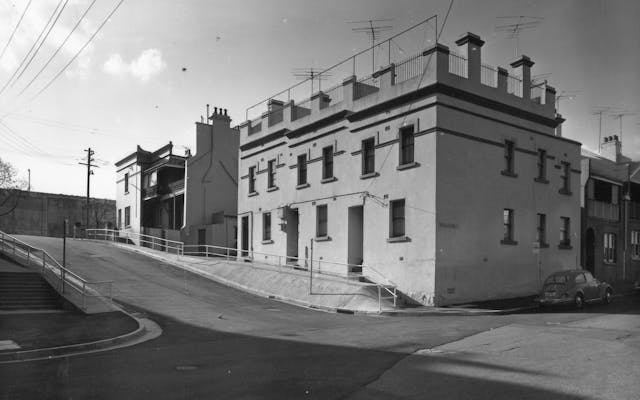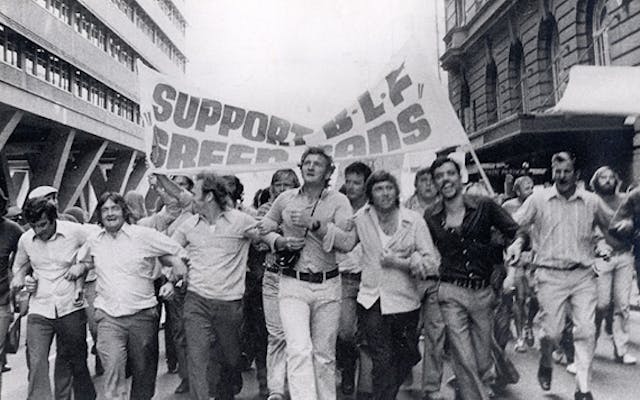By 1798, a naval dockyard had been commenced on the western side of Sydney Cove, the area known to the Gadigal people as ‘Tallawolladah’. It had ‘a workshop and storehouse for the joiners, watch-house, and an apartment for the clerk’, as well as a blacksmith’s workshop.
In 1800, a ‘commodious stone house near the naval yard’ was built as a residence for the Master of the Dockyard, later known as the Naval Officer’s House. The house featured a mansard roof with dormer windows and figures prominently in views of Sydney Cove prior to its demolition in the 1830s.
The first occupant was Master of the Dockyard Thomas Moore (1762–1840), who had married Surgeon John White’s de-facto wife Rachel Turner when White left the colony in 1794. Moore had been carpenter on the ship Britannia from 1792 to 1796, participating in whaling expeditions out of Sydney in the waters around New Zealand. In an 1806 report to Governor William Bligh he listed necessary repairs to the Yard:

The Dock Yard – wants Sheds for Boats, and to work under for Saw-Pits; the Blacksmith’s Shop and Store Houses and watchman’s Hut want Plaistering, whitewashing, new Doors and Shutters, rep’g Tiles outside of Staircase, Also New Posts and Railing next the Road. Wharfinger’s Hut – wants New windows and doors, Plaistering, whitewashing, a new Chimney, and Tileing required. (‘Statement of Government Buildings in Sydney Augt. 13th 1806’, Enclosure with Dispatch No. 1, Bligh to Wyndham 25 January 1807, Historical Records of Australia, Vol. 6 pp. 98–9.)
Moore retired in 1809, and was succeeded after a time by William Cossar, Superintendent of the Dockyard 1812–18. By 1810, a series of four dry docks had been cut into the sandstone of the shore, remains of three of these were identified by archaeologists during extension work to the Museum of Contemporary Art in the late 1990s.
By 1810, sufficient children had been born in the colony to train as boat-builders, apprenticed for seven years from the ages of 13 or so. In 1808 John Wood (1795–1883) was apprenticed, along with George Bloodsworth (1796–1840), son of the builder James Bloodsworth.
The following year John Jones, Leonard Dark (1796–1837) and Thomas Day (1795–1868) were taken on. The Rocks businesswoman Ann Mash (1767–1823) had her son William Henry Chapman (1801–57) apprenticed to the Dockyard in 1817. In 1822, this young man petitioned Governor Sir Thomas Brisbane for a release from his seven-year indenture in order to accompany the Reverend Walter Lawry (1793–1859) on a missionary expedition to Tonga.
In his letter, he reminded the Governor that he had constructed for him a gig (rowboat) and was in the process of completing a lifeboat. Both W.H. Chapman and Thomas Day went on to be master boat-builders in Millers Point.
Obed West (1807–91), writing in 1882, recalled the scene around the Dockyard in his youth, around 1816–17:
At this dockyard I can recollect watching with boyish interest a brig under construction. This vessel when launched was called the Macquarie* and was used in conveying prisoners and stores to the penal establishments at Norfolk Island and the Coal (now Hunter) River. At the south corner of the Cove, opposite Globe-street, was the only public wharf — known as the King's Wharf — which Sydney boasted of, and where nearly all the goods for the colony— in fact Australia — were landed; and I may add it was quite large enough for all requirements.… The remaining portion of the shores of the Cove was in its natural state, while near King's Wharf, on the southern shore, the waters of the celebrated Tank Stream flowed into the bay… Commencing at the northern end of George-street the house passed was a weatherboard one, where the Mariners’ Church now is. It was occupied by Captain Piper, and opposite was Mr. Garling's cottage, and on the other side were the Government boatsheds, Mr B. Williams being at the time the Government coxswain. Another house was that of Mr Greenway, the Colonial Architect. (Sydney Mail 29 Jul 1882, p172) *The boat, commenced in 1797, was finally launched in 1816 as the Elizabeth Henrietta, named after the wife of Governor Macquarie. The ship was wrecked at Newcastle in 1825.
The Dockyard remained in full operation with a workforce of 57 convicts and free contractors until 1831 when it was downsized, and work outsourced to private shipyards. Fourteen men were retained for basic repair work. Little mention of the Dockyard appears in the 1830s and 1840s, as plans to create Circular Quay were formulated and the construction of the Quay land-locked the dry docks, rendering them useless.
The Dockyard was further encroached upon when the Commissariat Stores were enlarged in 1847 and in 1857 when Argyle Street was extended to the newly formed quayside. At this time also a new naval dockyard was under construction at Cockatoo Island, which operated until the 1990s.











